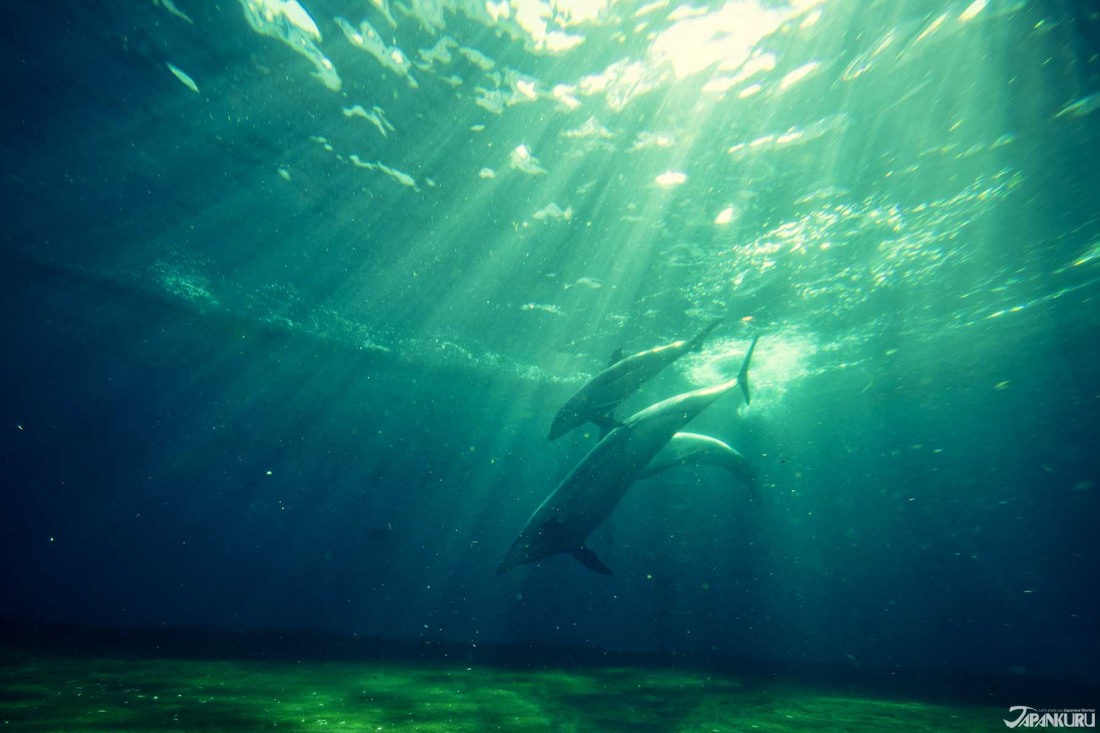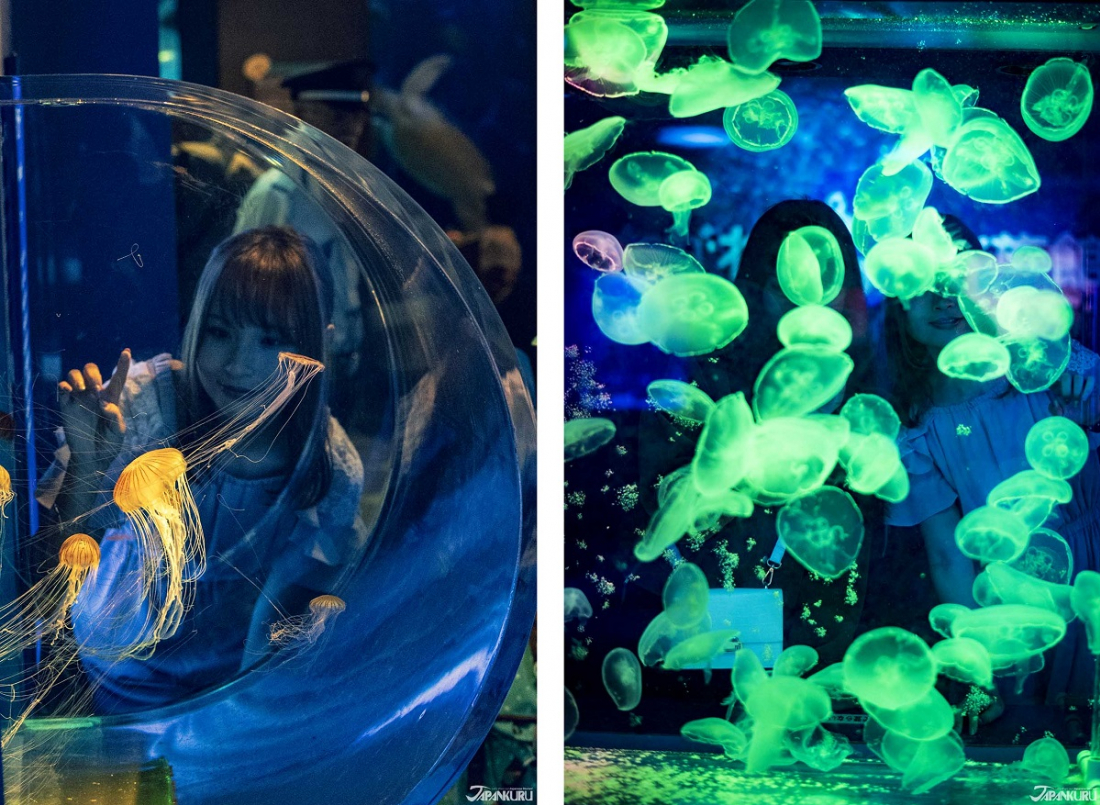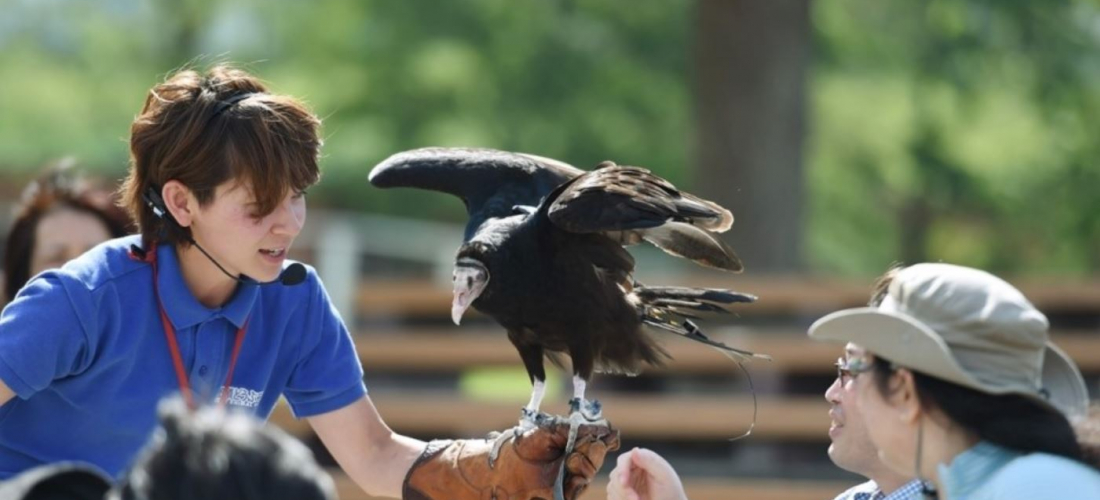
CONTENTS
A perfect Tokyo aquarium for families with children, or adults who like to get up close and personal with the residents of the sea, Shinagawa Aquarium’s exhibits are set up so that animal-lovers of all ages can get a great look at all the creatures living there. With totally reasonable ticket prices (which include dolphin shows, seal shows, sea lion shows, and more) and well taken care of animals, Shinagawa Aquarium is worth a place in your Tokyo itinerary.
The Flow of the Shinagawa Aquarium
Take a few steps into the Shinagawa Aquarium and you'll be transported to the mountainous streams and rivers that flow from natural freshwater sources in the heart of Japan. That's because the layout of the aquarium is set up to guide visitors along the cycle of water flowing throughout the world. After first getting a look at the fish that jump waterfalls and swim through the rushing river water of Japan's mountainous countryside, the tour brings you to see the residents of sandy beaches and rocky shores that line Japan's island borders. Cross those, and the world opens up in front of you, right inside the Shinagawa Aquarium. Start small with displays of fish from the Tokyo Bay, and the natural bodies of water right in the Shinagawa area. Then branch out – the aquarium has tanks with colorful tropical fish from waters closer to the equator, displays focusing on creatures from the Mekong River in Southeast Asia and the Amazon River far off in South America, plus animals that roam the seas and travel all over the world. From local wildlife to fish who make their homes around the world, the Shinagawa Aquarium offers you and your little ones a far-reaching tour of the world's aquatic life, all in a compact aquarium setting.
3-2-1 Katsushima, Shinagawa-ku, Tokyo
10:00 – 17:00 (final entry 16:30)
Adults: 1,350 yen | Elementary/Middle Schoolers: 600 yen | Children: 300 yen
Official Website
Why You Need to Add Shinagawa Aquarium to Your Itinerary
Reason ① The Animals Come So Close, It’s Like You’re Right in There With Them!
Have you ever had a seal swim inches under your feet? Or had a shark slink right up to your face and look you in the eye? Every step of the way, the animals feel so close, it's like they might just swim through the glass and do a few loops around your head (although we were assured that the creatures were safely secured within sturdy enclosures). Sometimes the thick glass that separates you from the water in aquariums make it feel a little like looking through a TV screen, but not at Shinagawa Aquarium!
The Aquarium Tunnel
When you're buying a house, "low ceilings" sound bad, but when you're talking about an aquarium tunnel, low ceilings make for an amazing experience. This tunnel is carved out of a 500-ton tank, populated by 900 ocean-dwellers of more than 60 different kinds. With the unusually low ceiling overhead, those creatures come closer than you'd expect. Giant rays sweep through the water just above your head, while marine fish give you side-eye as they saunter past. Rather than feeling claustrophobic, a stroll through the tunnel makes you feel like you're drifting through the great wide ocean with the fish of the sea.
The Spotted Seals
Check out the seal enclosure, and you'll be a little amazed at how many angles you can explore. From above you can see the seals peeking out of the watery depths, with their wet noses resting on the rocks. They're at a distance that's safe for you and the animals, but it feels like you could almost reach out a hand and give their heads a little rub. (One of the seals is even a little famous for curling up and napping in one of the circular windows that connect the inside and outside areas, so look out for the donut of chubby spotted seal when you visit!)
If you walk down the stairs, you'll find a second aquarium tunnel, this one inhabited just by the seals. It's the rest of their enclosure! The tunnel seems like it breaks up the tank into different areas, but they're actually all connected. Don't be shocked if a seal literally comes up under you and checks out the soles of your shoes through the glass!
Reason ② Fun for the Whole Family
When you're traveling with kids the ideal destinations are those that entertain then while also teaching them a little more about the world, which is why we heartily recommend the Shinagawa Aquarium for families traveling in Tokyo. The aquarium is pretty fantastic if you can read a little Japanese, with interesting signs talking about each of the displays, but still mixes a little education in with the fun for those who can't read the signage. For budding young marine biologists, labels with common names and scientific names are arranged around tanks (have they learned about binomial nomenclature yet?), and lots of the educational displays are visual representations that are clear enough even without reading the text. There are also great shows, showing off the intricate bodies and instincts of the creatures in the aquarium (more on that below)! And for parents, the aquarium is set up with plenty of facilities to make your life easier when it comes to breastfeeding and changing diapers.
Of course, perhaps most importantly, there are lots of exhibits at comfortable eye-level for kids of all ages!
Reason ③ It’s a Totally Affordable Outing in Busy Tokyo
Especially when you're touring a big city like Tokyo, travel expenses can add up, but that's no reason to skimp on the experiences you and your family are bound to enjoy. At 1,350 yen for adults and less than half that for children's tickets, the Shinagawa Aquarium is priced extremely reasonably for an aquarium – especially when you factor in all the shows you can see for free at that price. You can easily while away a happy and relaxed afternoon at the aquarium, with plenty to entertain children and adults alike. Keep reading to find out exactly what there is to do.
The Best Parts of Your Visit – Don’t Miss Them!
① Four Different Shows!
Not one, not two or three, but four different kinds of shows are put on regularly at the Shinagawa Aquarium. Working closely to create strong bonds with the animal performers, the Shinagawa Aquarium staff create shows that are both a joy to watch and pretty interesting to listen to (especially if you can pick up a little of the Japanese).
Sea Lion Shows
Agile in the water but good with their front flippers in all environments, sea lions are mischevious and clever. Thanks to the time the Shinagawa sea lions share with their caretakers, working together in ways enriching for the animals and clearly fun for the staff, these slippery guys can also pull off some cool tricks! Check out just what they can do with their long appendages and dynamic movements.
Seal Shows
If you're not a frequent aquarium visitor you might not be all that well-acquainted with the differences between seals and sea-lions. While sea lions like to hop onto the beach and manipulate things with their front flippers, seals (like the spotted seals at Shinagawa Aquarium) have bigger bodies and much smaller limbs, meaning they're clumsier out of the water. That's probably why they spend less time out of the sea. Swimming through the waves, though, spotted seals are surprisingly powerful and can jump right out of the water.
You can see how fun and natural it is for them to explode out of the tank during the seal shows, reaching high into the air!
Dolphin Shows
Of course Shinagawa Aquarium has dolphin shows too, put on in an arena mostly taken up by the huge dolphin tank. Watch out for splashes, because you can sit right up close! Right now is a special time for the Shinagawa dolphins, as well, with a series of dolphin births happening just recently, right in the aquarium! If you were wondering why the floor of the tank was all green, the (unreasonably adorable) baby dolphins are actually the reason for that, too, since they're still getting used to new surroundings. The algae growing in the enclosure is totally harmless, and the deep cleaning needed to keep the water crystal clear requires draining the tank. The adult dolphins are usually moved over to a neighboring tank during that cleaning process, so they're just letting things be to keep the dolphin calves comfortable until they adjust to being in both tanks.
The babies are pretty ridiculously cute. While the older dolphins perform in the shows, they get so enthusiastic they try to play along. Watch fully-grown dolphins jump high into the air, and then the small babies try their best to breach the water too!
Staff-Led Underwater Tank Shows
A little different from the other performances, the underwater shows at Shinagawa Aquarium feature staff diving into the water, swimming around the tunnel area, and talking to the gathered crowd about the animals through a mic inside their breathing mask. This is no recording! As the divers interact with the sharks, rays, and fish that swim by, they show off the animals and talk about what's going on in as it happens.
The underwater shows let you see aquatic creatures in a new light, watching them play around with the divers as they chow down on fishy snacks.
② Hands-on Experiences
Got kids that dream of sticking their hands in the tank? All grown up and you still want to get your hands wet? These are for you.
Getting Nibbled on by “Doctor Fish”
If you're intrigued by the idea of the "fish spas" that have spread across the world in the last 20 or so years, the Shinagawa Aquarium is a good place to dip a toe in the water (or actually just a finger!) Instead of the standard spa setup where you dunk your feet into a tank of red garra fish, here you can sample the experience with just your hands, slipping them into the tank like you might at a touch-tank in any other aquarium. Here, though, the fish flock to your fingers, nipping trace bits of dead skin off of you with a fun tickling sensation that can be a lot of fun for kids and adults alike.
Dig for Pearls!
These pearls may be cultured, but they're very real, which is why the pearl experience at Shinagawa Aquarium involves really getting in there with an oyster. Part of the fun is that you don't know what you're going to find! Pearls can vary in color, shape, and texture, and using the big tweezers to dig out your very own treasure is pretty exciting.
The pearl experience is provided by an outside group, which means that sometimes the workshop opening period depends on actual oyster pearl availability, but with a little luck you'll get to try it out and find your own one in a million pearl! It costs 1,000 yen to take part, plus an additional fee if you want to get the pearl set in a pendant or a keychain. They have a little drill made for that purpose, so they can set the pearl right then and there if you want!
③ Insta-bae (インスタ映え) Spots
Great Places for the Coolest Photo-ops
The Jellyfish Room
Instead of jellyfish lining the walls, Shinagawa Aquarium's jellyfish room has tanks that jut out, letting you walk around and see them from all kinds of angles, and making for some pretty cool pictures.
There's even a jellyfish frame, a relatively thin tank that acts like a jelly-fish filled window. It's like a marine-themed snapchat filter, except the jellyfish that lazily float past your face are totally real, and not illustrated recreations.
The same room has a globe filled with little fish, as well. Try standing on the other side while someone takes a picture, and see what happens!
The Mirrored Staircase
Angle this shot just right and the aquarium's little hall of mirrors will make it feel a little like you're in another world, perhaps even under the ocean!
Jewels of the Tropics
There are beautiful and interesting fish throughout the aquarium, but this tank contains a collection of Shinagawa's most colorful little reef fish. Thanks to the clear lighting, these gems glow vividly in the water, making for a great photo backdrop.
The “Jumping Dolphin” Parfait Next Door
If you've worked up a hunger making your way through Shinagawa Aquarium, you can always duck out of the building and head next door. (Restaurant Dolphin is technically a separate business, but they offer lots of marine-themed food and snacks, making it a pretty good lunch spot when you visit the aquarium!) Finish off your meal with one of their adorably on-theme jumping dolphin parfaits, with a little dolphin cookie leaping right out of the ice cream.
Just don't lose your Shinagawa Aquarium ticket while you eat! Hold on to it and you'll get free re-entry to the aquarium all day.
Restaurant Dolphin
3-3-2-1 Katsushima, Shinagawa-ku, Tokyo
Jumping Dolphin Parfait: 550~720 yen
Information Page
④ Unusual Animal Displays
The Electric Eel
Perhaps you've seen an electric eel before, but have you ever been able to see exactly how many volts it's producing in real time? The Shinagawa Aquarium eel is pretty used to us boring humans walking by every day, so it's normally just producing a fairly low-level charge, but get there when the eel is being fed and you'll see the number of volts jump up! Just for a moment.
Rivers of the World
Even if your kids don't speak Japanese, they'll probably have a good time pressing the buttons in the corners of this room, with Mekong and Amazon River fish on display. One of them will start a "thunder storm", with water drops falling onto the tank water and flashing "thunder and lightning" in the room. Pressing the other button will start a chat from, well, the tree! This arboreal friend teaches kids about the animals who live in rivers.
Penguins!
Love these feathery aquatic friends? At the Shinagawa Aquarium you can get right up to their open-air enclosure, a uniquely up-close penguin experience!
The Nitty-Gritty Details
Now that we've cleared all that up, the Shinagawa Aquarium is pretty easy to get to! Take a train to the JR Oimachi Station to hop on a free shuttle bus that goes straight to the aquarium! Shuttle bus times vary by day, but you can see all the schedules in Japanese here. They're fairly easy to understand even without any Japanese knowledge. If you go on a day with nice weather, though, we recommend you walk over! Fifteen minutes walk from Omori Station and just eight minutes from Omorikaigan Station, the trip takes you through the surrounding park, which is due to reopen completely as a relaxing new local green space in 2020.
Once you arrive, buying a ticket and checking the show schedule is a breeze.
One intriguing point that a fair number of travelers have noticed is how close the Shinagawa Aquarium is to Haneda Airport. That's right, if you're leaving on an evening flight and don't really know how to spend your last day (or perhaps decided to spend your last evening at an airport hotel and need something to do before you go), we'd recommend the aquarium! It's right on the way, and as long as you check in with them first, they're happy to hold onto your larger suitcases (that don't fit into a locker) behind the counter for a small fee, while you wander the aquarium. Make one last nice memory of Japan before you go!
All ready to spend the day with the aquatic life of Shinagawa Aquarium now? We'd love to hear how your trip goes, and see all the pictures you take with the aquarium's animals! Let us know about your experience on twitter, instagram, and facebook!
Details
NAME:Shinagawa Aquarium
MAP
ACCESS:Omorikaigan Station or JR Omori Station
COMMENT
FEATURED MEDIA
VIEW MOREMAP OF JAPAN
SEARCH BY REGION

LATEST
VIEW MOREEVENT CALENDAR
VIEW MOREMOST POPULAR
 Tokyo Winter Recommendation: Don’t Miss Tokyo Mega Illumination, Japan’s #1 Light Show
Tokyo Winter Recommendation: Don’t Miss Tokyo Mega Illumination, Japan’s #1 Light Show ป้ายยาสินค้าน่าซื้อในร้านขายยาญี่ปุ่น | KOWA ผลิตภัณฑ์เพื่อสุขภาพสำหรับคนยุคใหม่
ป้ายยาสินค้าน่าซื้อในร้านขายยาญี่ปุ่น | KOWA ผลิตภัณฑ์เพื่อสุขภาพสำหรับคนยุคใหม่ Okinawa Family Road Trip: Japanese Glasses Shopping at San-A Urasoe West Coast PARCO CITY, Discount Coupons, & Okinawa Sightseeing with JINS
Okinawa Family Road Trip: Japanese Glasses Shopping at San-A Urasoe West Coast PARCO CITY, Discount Coupons, & Okinawa Sightseeing with JINS



































 >> Find out more at Japankuru.com! (link in bio)
#
>> Find out more at Japankuru.com! (link in bio)
#





 The Robot Restaurant is gone, but the Samurai Restaurant is here to take its place. Check it out, and don't forget your coupon!
The Robot Restaurant is gone, but the Samurai Restaurant is here to take its place. Check it out, and don't forget your coupon!
 신주쿠의 명소 로봇 레스토랑이 사무라이 레스토랑으로 부활! 절찬 쿠폰 발급중
신주쿠의 명소 로봇 레스토랑이 사무라이 레스토랑으로 부활! 절찬 쿠폰 발급중
 18歲以上才能入場的歌舞秀,和你想的不一樣!拿好優惠券去看看~
#tokyo #shinjuku #samurairestaurant #robotrestaurant #tokyotrip #도쿄여행 #신주쿠 #사무라이레스토랑 #이색체험 #할인이벤트 #歌舞伎町 #東京景點 #武士餐廳 #日本表演 #日本文化體驗 #japankuru #japantrip #japantravel #japanlovers #japan_of_insta
18歲以上才能入場的歌舞秀,和你想的不一樣!拿好優惠券去看看~
#tokyo #shinjuku #samurairestaurant #robotrestaurant #tokyotrip #도쿄여행 #신주쿠 #사무라이레스토랑 #이색체험 #할인이벤트 #歌舞伎町 #東京景點 #武士餐廳 #日本表演 #日本文化體驗 #japankuru #japantrip #japantravel #japanlovers #japan_of_insta
 코지마 x 빅 카메라 쿠폰으로 일본 가전 제품 쇼핑하기
#pr #japankuru #japanshopping #kojima #biccamera #japaneseskincare #yaman #dji #osmopocket3 #skincaredevice #日本購物 #美容儀 #相機 #雅萌 #日本家電 #일본여행 #면세 #여행꿀팁 #일본쇼핑리스트 #쿠폰 #일본쇼핑 #일본브랜드 #할인 #코지마 #빅카메라 #japankurucoupon
코지마 x 빅 카메라 쿠폰으로 일본 가전 제품 쇼핑하기
#pr #japankuru #japanshopping #kojima #biccamera #japaneseskincare #yaman #dji #osmopocket3 #skincaredevice #日本購物 #美容儀 #相機 #雅萌 #日本家電 #일본여행 #면세 #여행꿀팁 #일본쇼핑리스트 #쿠폰 #일본쇼핑 #일본브랜드 #할인 #코지마 #빅카메라 #japankurucoupon

































 Oita Hello Kitty Airport
Oita Hello Kitty Airport  Lands April 13th
Lands April 13th





















